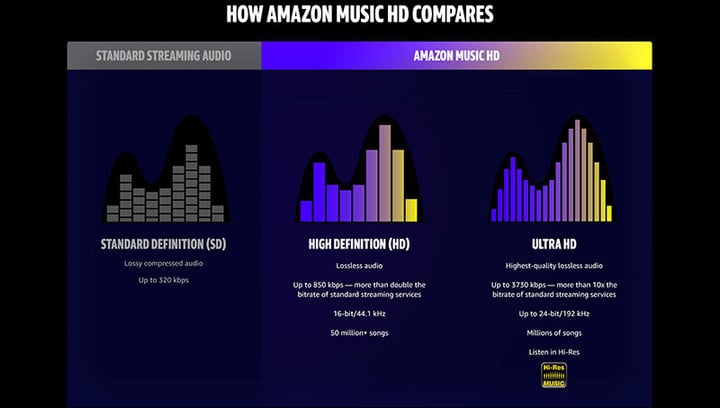Amazon’s Prime has become a benchmark for paid members, compared to its other fee-based service, Amazon Music, which has a lower sense of focus. Today, the focus of streaming music in the US is mainly in Spotify and Apple. Music, so in order to eat from the two giants, Amazon Music put a big move yesterday: lossless music.

As with most online music platforms, Amazon Music currently offers a standard sound quality of 320kbps for $9.99 per month, and a lossless music package of $14.99 per month. If it is a Prime user, it can be cheaper. 2 US dollars, and new users can get up to 9A 0-day free trial, which is cheaper than the loss-free music subscription platform Tidal, which costs $19.99/month.
Amazon claims that its library has more than 50 million High Definitions, 64-bit bit depth, 44.1 kHz sample rate CD quality songs, and millions of 24-bit bit depths, with a sampling rate of 44.1. “Ultra HD” songs from kHz to 192 kHz. The above songs all use the FLAC lossless file format, and Tidal uses the MQA format.

▲ Image from: Amazon Music
Amazon Music Vice President Steve Boom vs. The Verge explains themSo HD and Ultra HD are used to describe lossless music because they find it easier to understand than proper nouns. They don’t want Amazon Music to be a niche lossless music platform like Tidal or Qobuz.
As such, Amazon Music is targeting the market where Spotify and Apple Music are located. Spotify has tested lossless music, but has not yet launched a special package. Apple’s AAC is far better than MP3, but no matter how good Apple technology is, it is impossible to turn loss into damage.
Spotify, Apple Music, and Amazon Music (Standard Edition) are priced at $9.99 a month. If Amazon’s lossless music does achieve the same as the official claims of surpassing or even surpassing CD quality, it is a difference between Amazon Music and its competitors. The way, but lossless music is a relatively niche demand. Most users may not be able to distinguish from standard music. The public opinion migrates to the new platform and costs $5 more per month.
MIDiA Research’s survey shows that only 4% of respondents do not use online music services because of lack of sound quality. “The difference in sound may not be enough to increase the charges for existing streaming media,” said music analyst Zach. Zach Fuller pointed out.
Therefore, although there are certainly users who have a higher demand for sound quality, if Amazon wants to compete with Apple and Spotify for the user, there is only one lossless music.
The title map is from: Unsplash